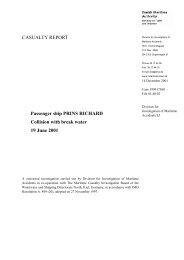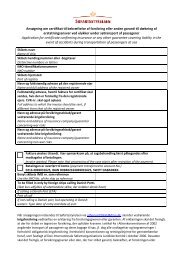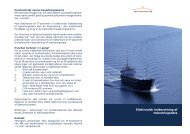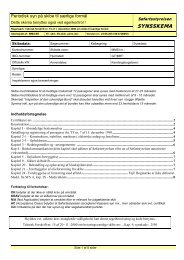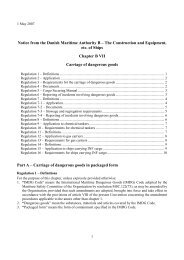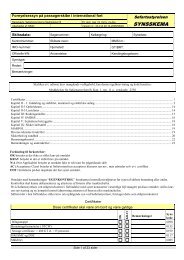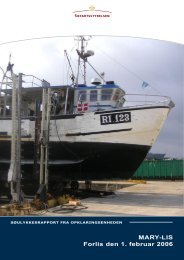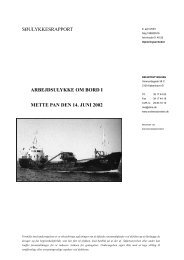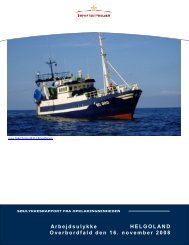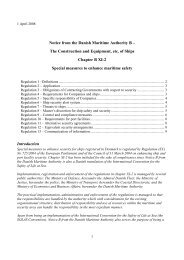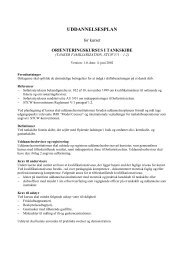Notice from the Danish Maritime Authority B
Notice from the Danish Maritime Authority B
Notice from the Danish Maritime Authority B
Create successful ePaper yourself
Turn your PDF publications into a flip-book with our unique Google optimized e-Paper software.
Regulation 2 – Definitions<br />
For <strong>the</strong> purpose of this chapter, unless expressly provided o<strong>the</strong>rwise:<br />
1. Subdivision length (L s ) of <strong>the</strong> ship is <strong>the</strong> greatest projected moulded length of that part of <strong>the</strong> ship<br />
at or below deck or decks limiting <strong>the</strong> vertical extent extent of flooding with <strong>the</strong> ship at <strong>the</strong><br />
deepest subdivision draught.<br />
2. Mid-length is <strong>the</strong> mid-point of <strong>the</strong> subdivision length of <strong>the</strong> ship<br />
3. Aft terminal is <strong>the</strong> aft limit of <strong>the</strong> subdivision length.<br />
4. Forward terminal is <strong>the</strong> forward limit of <strong>the</strong> subdivision length.<br />
5. Length (L) is <strong>the</strong> length as defined in <strong>the</strong> International Convention on Load Lines in force.<br />
6. Freeboard deck is <strong>the</strong> deck as defined in <strong>the</strong> International Convention on Load Lines in force.<br />
7. Forward perpendicular is <strong>the</strong> forward perpendicular as defined in <strong>the</strong> International Convention on<br />
Load Lines in force.<br />
8. Breadth (B) is <strong>the</strong> greatest moulded breadth of <strong>the</strong> ship at or below <strong>the</strong> deepest subdivision<br />
draught.<br />
9. Draught(d) is <strong>the</strong> vertical distance <strong>from</strong> <strong>the</strong> keel-line at mid-length to <strong>the</strong> waterline in question.<br />
10. Deepest subdivision draught (d s ) is <strong>the</strong> waterline which corresponds to <strong>the</strong> summer load line of<br />
<strong>the</strong> ship.<br />
11. Light service draught(d l ) is <strong>the</strong> service draught corresponding to <strong>the</strong> lightest anticipated loading<br />
and associated tankage, including, however, such ballast as may be necessary for stability and/or<br />
immersion. Passenger ships should include <strong>the</strong> full complement of passengers and crew on board.<br />
12. Partial subdivision draught (d p ) is <strong>the</strong> light service draught plus 60% of <strong>the</strong> difference between<br />
<strong>the</strong> light service draught and <strong>the</strong> deepest subdivision draught.<br />
13. Trim is <strong>the</strong> difference between <strong>the</strong> draught forward and <strong>the</strong> draught aft, where <strong>the</strong> draughts are<br />
measured at <strong>the</strong> forward and aft terminals respectively, disregarding any rake of keel.<br />
14. Permeability (µ) of a space is <strong>the</strong> proportion of <strong>the</strong> immersed volume of that space which can be<br />
occupied by water.<br />
15. Machinery spaces are spaces between <strong>the</strong> watertight boundaries of a space containing <strong>the</strong> main<br />
and auxiliary propulsion machinery, including boilers, generators and electric motors primarily<br />
intended for propulsion. In <strong>the</strong> case of unusual arrangements, <strong>the</strong> Administration may define <strong>the</strong><br />
limits of <strong>the</strong> machinery spaces.<br />
16. Wea<strong>the</strong>rtight means that in any sea conditions water will not penetrate into <strong>the</strong> ship.<br />
17. Watertight means having scantlings and arrangements capable of preventing <strong>the</strong> passage of water<br />
in any direction under <strong>the</strong> head of water likely to occur in intact and damaged conditions. In <strong>the</strong><br />
damaged condition, <strong>the</strong> head of water is to be considered in <strong>the</strong> worst situation at equilibrium,<br />
including intermediate stages of flooding.<br />
18. Design pressure means <strong>the</strong> hydrostatic pressure for which each structure or appliance assumed<br />
watertight in <strong>the</strong> intact and damage stability calculations is designed to withstand.<br />
19. Bulkhead deck in a passenger ship means <strong>the</strong> uppermost deck at any point in <strong>the</strong> subdivision<br />
length (L s ) to which <strong>the</strong> main bulkheads and <strong>the</strong> ship’s shell are carried watertight and <strong>the</strong><br />
lowermost deck <strong>from</strong> which passenger and crew evacuation will not be impeded by water in any<br />
stage of flooding for damage cases defined in regulation 8 and in part B-2 of this chapter. The<br />
bulkhead deck may be a stepped deck. In a cargo ship <strong>the</strong> freeboard deck may be taken as <strong>the</strong><br />
bulkhead deck.<br />
3



